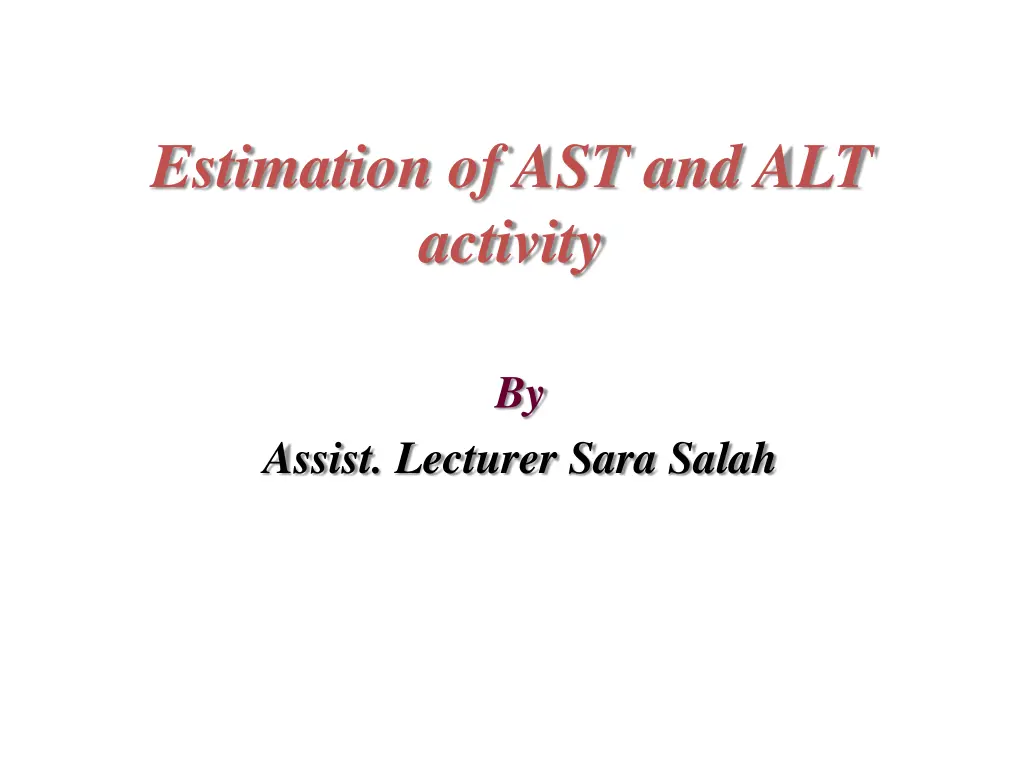
Understanding Transamination and Aminotransferases in Liver Function
Learn about transamination, a vital process transferring amino groups, and the types of aminotransferases such as AST and ALT. Discover the causes of raised AST activity and the correlation between AST and specific medical conditions.
Download Presentation

Please find below an Image/Link to download the presentation.
The content on the website is provided AS IS for your information and personal use only. It may not be sold, licensed, or shared on other websites without obtaining consent from the author. If you encounter any issues during the download, it is possible that the publisher has removed the file from their server.
You are allowed to download the files provided on this website for personal or commercial use, subject to the condition that they are used lawfully. All files are the property of their respective owners.
The content on the website is provided AS IS for your information and personal use only. It may not be sold, licensed, or shared on other websites without obtaining consent from the author.
E N D
Presentation Transcript
Estimation of AST and ALT activity By Assist. Lecturer Sara Salah
What is transamination? It is a process in which alpha amino group from an amino acid is transferred to an alpha keto acid It is catalyzed aminotransferases and the coenzyme is always pyridoxal phosphate Glutamate is one of the reaction partners Only threonine and lysine do not derive their amino groups by the transamination reaction by the enzymes
What are types of aminotransferases? Aspartate aminotransferase (glutamate-oxaloacetate transaminase-GOT) Alanine aminotransferase glutamate-pyruvate transaminase - GPT) AST is found in mitochondria of liver, heart, skeletal muscle, kidney, pancreas and lesser extent in RBCs. Note : It is released in to the serum in proportion to cellular damage (AST)or (ALT) or the cytoplasm and
Causes of raised AST activities: Artefactual: Duo to in vitro release from enterocyte if there is hemolysis or separation of plasma from cells is delayed . Physiological: During neonatal period (about 1.5 times the upper adult reference limit ) Marked increase (10-100 times normal) Circulatory failure with shock and hypoxia MI Acute viral or toxic hepatitis
Moderate increase: Cirrhosis Infectious mononucleosis Cholestatic jaundice Malignant infiltration of liver Skeletal muscle disease After trauma or surgery Sever hemolytic episode
There is a high correlation between MI and AST but because of its low organ specificity other test must be measured including CPK and LDH .
ALT appears primarily in hepatocellular cytoplasm with lesser amount in kidney, heart, skeletal muscles, therefore it is more specific indicator of acute hepatocellular damage in which it is released to the bloodstream with jaundice appears then return to normal within days or weeks It is twice higher in infants than in adults
Causes of raised plasma ALT: Marked increase: (10-100 times normal) Circulatory failure with shock and hypoxia Acute viral or toxic hepatitis Moderate increase: Cirrhosis Infectious mononucleosis (due to liver involvement) Liver congestion in CHF Cholestatic jaundice (up to 10 times normal) Surgery or trauma and skeletal muscle disease (much less affected than AST)
What is GOT/GPT ratio? It is obtained by dividing GOT/GPT Its normal range 1-1.3 It is changed in certain diseases where cell membranes permeability is increased ( ratio decreases) or in cellular increases). Note: serum GOT and GPT rises whenever disease affect liver cell, GPT is more liver specific enzyme, while GOT is heart specific enzyme. damage (ratio
What aminotransferases level? are medications that affect Pain relief medications: Aspirin Acetaminophen Diclofenac Ibuprofen Anti-seizures: Phenytoin Carbamazepin phenobarbital
Antibiotics: Tetracyclin Sulphonamides Cholesterol lowering drugs: Statins Niacin Cardiovascular drugs: Amiodarone Hydralazine Tricyclic antidepressants Note : the enzyme usually normalize weeks to months after stopping the medication.






















